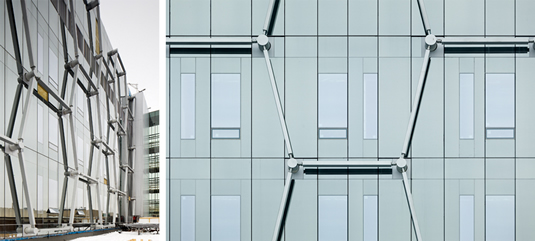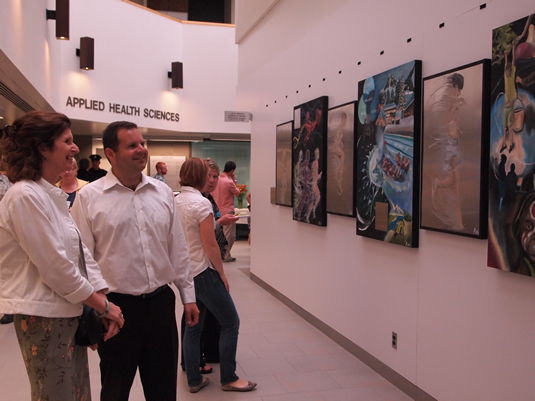- Three researchers awarded Banting fellowships
- "The most complex building...in North America"
- Tuesday's notes
- Editor:
- Brandon Sweet
- Communications and Public Affairs
- bulletin@uwaterloo.ca
Susan Elliott, dean of applied health sciences, joins Kinesiology alumnus and artist Scott Kish for the unveiling of a series of seven commissioned art panels to adorn the BMH Foyer. The work features human figures in motion on brushed aluminum and collages representing applied health sciences’ focus on preventing illness and injury and optimizing health and well-being throughout the lifespan, at work and at leisure.
Photograph by Michelle Douglas-Mills.
Three researchers awarded Banting fellowships
Could gravity become a tool in quantum information science? Is sustainability able to incorporate both human and environmental needs? Can we build a computer that sees? Three top researchers at the University of Waterloo have been awarded prestigious Banting Postdoctoral Fellowships to probe these and other questions.
The two-year, $70,000 Banting fellowships have been awarded to three top researchers at the University of Waterloo. James Bergstra and Eduardo Martin-Martinez have received the fellowships from the Natural Sciences and Engineering Research Council of Canada (NSERC). Prateep Nayak was awarded a Banting fellowship by the Social Sciences and Humanities Research Council (SSHRC).
“We are delighted to attract these three world-class young scholars to the University of Waterloo,” said Sue Horton, associate provost, graduate studies at Waterloo. “The Banting fellowships enable to us to compete internationally for these extraordinarily talented individuals."
Bergstra’s research uses computer simulation to replicate vision. His theory is that our retina divides vision into familiar image fragments. Our brains then decode them using simple mathematical transformations. Using insights from cognitive neuroscience, his work has exciting potential applications to human vision and artificial intelligence. He comes to Waterloo from the Rowland Institute at Harvard, and will work with Professor Chris Eliasmith, the Canada Research Chair in Theoretical Neuroscience, in the Centre for Theoretical Neuroscience.
“Much has been discovered about the function and anatomy of the human brain, but replicating sight in computer simulations remains a challenge,” said Bergstra.
Eduardo Martin-Martinez works in quantum information science. His field of specialization — the quantum effects induced by gravity — has seen a huge expansion worldwide. Martin-Martinez will probe gravity’s impact on quantum information, seeking novel effects, higher reliabilities in information processing protocols, and greater understanding of quantum entanglement.
Martin-Martinez has completed more than 20 refereed articles, with more than 275 citations, has been published in leading journal Physical Review Letters. At Waterloo, he will work with Professor Achim Kempf, Canada Research Chair in the Physics of Information.
“The project has a strong potential to produce contributions to quantum information science and technology, quantum optics, quantum simulations and quantum gravity,” said Martin-Martinez.
Sustainability researcher Prateep Nayak is a Trudeau scholar and former Giorgio Ruffolo Doctoral Fellow in Sustainability Science at Harvard University’s Center for International Development. His work examines ecosystems as social-ecological entities, in which both human actions and biophysical systems affect each other. These systems are subject to abrupt, often irreversible change thanks to climate change, globalization and other factors. Nayak explores these massive shifts, and evaluates their implications for governance.
“Quality of life of people, in Canada and globally, is integrally linked to the environment,” said Nayak. “Insights from this research will offer novel tools and methods for freshwater, marine, coastal and forest ecosystems’ sustainable use, and thereby contribute to food security and human well-being.”
The Banting Postdoctoral Fellowships Program is designed to attract and retain top-tier postdoctoral talent, both nationally and internationally, to develop their leadership potential and to position them for success as research leaders. Seventy new fellowships are awarded each year.

"The most complex building...in North America"
The construction barriers have come down from in front of the Mike & Ophelia Lazaridis Quantum-Nano Centre as the countdown widget on the Institute for Quantum Computing's website ticks resolutely towards the cutting of the ribbon on Friday. Eight days later, on Saturday, September 29, the centre's doors will swing open for an open house filled with public lectures, special events, and tours.
Visitors will find a lot to take in. The 285,000 square foot, $160 million research facility was designed by KPMB Architects in close consultation with researchers from the Institute for Quantum Computing and the Waterloo Institute for Nanotechnology. These discussions informed the design of the interior and exterior of the building.
The layout of the building can be thought of as a bar and a box. The two buildings-within-a-building are organized above a shared podium that houses an advanced metrology suite and a 6,700 square foot cleanroom.
The Institute for Quantum Computing is housed in the bar-shaped building oriented east to west. Conceptually inspired by the Newton Institute in Cambridge, England, the design arranges "mind spaces" —lounges, offices, meeting rooms—around an atrium designed to promote interdisciplinary interaction.
The box, which houses the Waterloo Institute for Nanotechnology, features an exterior hexagonal honeycomb structural steel lattice, the pattern of which is inspired by the stable structure of a carbon nanotube. The lattice is essential to support the cantilevered perimeter office space.
Friday's ribbon-cutting will take place in the six-storey, sun-lit atrium that links the two sections of the centre together. The atrium features suspended stairs and functions not only as an indoor pedestrian route but also as an informal gathering space for researchers and students from both institutes sharing the facility.
The state of the art building has taken several years to design and construct because of the stringent scientific standards required for a facility of its kind. At a meeting of the university's board of governors in 2011, Paul Koenderman, CEO of Aecon Inc., the company charged with the task of bringing the architects' plans to life, said "this is the most complex building, in terms of mechanical and electrical and exotic services, than any other building in North America."
Some of those exotic services include:
- Vibration dampening: the cleanroom/fabrication facility is built on a separate foundation from the rest of the building atop deeply embedded shock-absorbing material. Even if the main building vibrates a little, the cleanroom won't move more than a fraction of the width of a human hair. So crank up the dubstep, Bombshelter DJs.
- Fresh air. Really fresh: The cleanroom is rated as a Class-1000 facility, which means a cubic foot of its air contains no more than 1,000 particles, and some areas of the facility are rated for 100 particles, or Class-100. By comparison, untreated outdoor air can range in the millions of particles. Such a pure environment is necessary for work inside the facility, such as lithography systems so precise they can pattern designs as small as 20 billionths of a metre across.
Mechanical and electrical designs have also been employed to achieve an environment with low electromagnetic interference and minimal radio frequency interference.
The architects designed the building to foster conversations and collaborations across disciplines through its many meeting rooms, the atrium, auditorium, and the whiteboards on practically every wall. The intention is that however different their backgrounds, scientists will meet here, trade ideas, and change the world.
Photograph by Tom Arban.
Tuesday's notes
The University of Waterloo is participating in this year's International Plowing Match in Roseville. The competitive plowing event, now in its 99th year, gets going today and the University of Waterloo will be taking part in the education tent programming, offering fun activities and experiments for children. Peter Russell, curator of Waterloo's Earth Sciences Museum, will also make two special presentations on groundwater. The International Plowing Match runs until Saturday, with gates opening daily at 8:30 a.m. and running until 5:00 p.m.
Feridun Hamdullahpur will be delivering a keynote address entitled "Innovating a Brighter Future"at the Greater KW Chamber of Commerce's Point of View event at the Waterloo Inn at 11:30 a.m. this morning.
WatIAM password reminder
Information Systems & Technology (IST) is reminding the campus community that a switch from ADS to Nexus passwords will go into effect Wednesday, September 19, and will affect the following IT services:
• Eduroam (wireless)
• uw-unsecured (wireless)
• LEARN
• JobMine
• Quest
• myHRinfo
• myPENSIONinfo
• VPN
• DialUp
• Central Authentication Service (CAS)
• 802.1x (wired public access point)
Currently, these services use your ADS password.
What does this mean? If you have changed your password in WatIAM within the last 18 months, nothing, but if your password is older then you need to set your password in WatIAM before tomorrow's changes take effect.
If your mobile device and/or computer (e.g. laptop, iPad) connects to the wireless network using your saved userid and password then you will need to update your password on those devices as well.
For details on how to test your password and make the changes, consult the network authentication change page.
Link of the day
When and where
Graduate Studies Fair, Tuesday, September 18, 11:00 a.m. to 1:30 p.m., Student Life Centre Great Hall. Details.
Chemistry Department Seminar Series featuring Prof. Gregory Welch, Department of Chemistry, Dalhousie University, "Molecular Materials for Solution Processed Organic Solar Cells," Tuesday, September 18, 2:30 p.m., C2-361.
Centre for Career Action Volunteer Fair, Wednesday, September 19, 11:00 a.m. to 2:30 p.m., Student Life Centre Great Hall.
Postdoc orientation and welcome event, Wednesday, September 19, 12:00 p.m., DC 1301. Details.
UWRC Book Club, "Lakeland" by Allan Casey (Region of Waterloo One Book, One Community selection), Wednesday, September 19, 12:00 p.m., LIB 407.
Waterloo Lecture featuring Douglas Cowan, "Sacred Space: The Quest for Transcendence in Science Fiction Film and Television," Wednesday, September 19, 7:00 p.m., Stratford Public Library, 19 St. Andrew St., Stratford. Hosted by the Waterloo Stratford Campus.
UW Farmer's Market, Thursday, September 20, 9:00 a.m. to 1:00 p.m., Student Life Centre Great Hall. Details.
Chemistry Department Seminar Series featuring Prof. Warren Chan, Department of Chemistry, University of Toronto, "The Complexities of Nanoparticle Tumor Targeting on Thursday, September 20, 2:30 p.m., C2-361.
Mike & Ophelia Lazaridis Quantum-Nano Centre ribbon cutting, Friday, September 21, 10:00 a.m.
Knowledge Integration Seminar featuring Kevin Thomason, "We All Want to Save the Planet...Don't We?" Friday, September 21, 2:30 p.m., Environment 3, room 1408.
School of Planning Induction Ceremony, Saturday, September 22, reception at 9:30 a.m. in the Environment 3 atrium, ceremony at 11:00 a.m. in Theatre of the Arts, Modern Languages.
Ottawa Alumni Networking event, Tuesday, September 25, 5:15 p.m. to 8:00 p.m. Details.
Career Fair, Wednesday, September 26, 10:00 a.m., Bingeman's, Kitchener. Details.
Pension Lunch and Learn Session, Wednesday, September 26, 12:00 p.m., DC 1302. Details.
Rotary Scholarship Dinner for UW Stratford Campus, Wednesday, September 26, 6:15 p.m., Rotary Club of Stratford. Details.
Geography lecture series featuring Peter Johnson, University of Waterloo, "Visioning Local Futures: Agent-based Modelling as a Tourism Planning Support System," Friday, September 28, 1:30 p.m., AL 113.
St. Jerome's Alumni Golf Classic, Saturday, September 29, 8:00 a.m., Grey Silo Golf Club. Contact Kelly Macnab at kmacnab @uwaterloo.ca for details.
Reunion 2012, Saturday, September 29, 8:00 a.m. to 11:00 p.m., various locations on campus.
Mike & Ophelia Lazaridis Quantum-Nano Centre public open house, Saturday, September 29, 10:00 a.m. Details.
WISE Lecture Series featuring Xavier Vallvé, International Consultant and Partner, Trama TecnoAmbiental, Barcelona, "Hybrid Photovoltaic Power Systems and Rural Micro Grids: Lessons Learned and Case Studies in Developing Countries," Monday, October 1, 5:00 p.m., DC 1304. Details.
Grad Studies Info Reception – Engineering, Wednesday, October 3, 6:00 p.m.– 8:00 p.m., E5 Student Design Centre. Details.
CrySP Speaker Series on Privacy and Sociology and Legal Studies presents Dr. Ian Kerr, University of Ottawa, "Repo Men Are Coming: Body EULAs, Privacy and Security of the Person," Wednesday, October 10, 1:30 p.m., DC 1302. Details.
